Giraffe
- Richprins
- Committee Member
- Posts: 76101
- Joined: Sat May 19, 2012 3:52 pm
- Location: NELSPRUIT
- Contact:
Re: Giraffe vs. hyenas
Please check Needs Attention pre-booking: https://africawild-forum.com/viewtopic.php?f=322&t=596
- Peter Betts
- Posts: 3084
- Joined: Fri Jun 01, 2012 9:28 am
- Country: RSA
- Contact:
Re: Giraffe
Cute little guy on the S 90 between Balule (where we were camping) and Bangu Gorge at sunset Give it a Click
- Lisbeth
- Site Admin
- Posts: 67578
- Joined: Sat May 19, 2012 12:31 pm
- Country: Switzerland
- Location: Lugano
- Contact:
Re: Giraffe
The neck still has to grow
"Education is the most powerful weapon which you can use to change the world." Nelson Mandela
The desire for equality must never exceed the demands of knowledge
The desire for equality must never exceed the demands of knowledge
- Lisbeth
- Site Admin
- Posts: 67578
- Joined: Sat May 19, 2012 12:31 pm
- Country: Switzerland
- Location: Lugano
- Contact:
Re: Giraffe
Dwarf giraffes seen in Namibia and Uganda
Posted on January 4, 2021 by Giraffe Conservation Foundation

By Giraffe Conservation Foundation
Researchers from the Giraffe Conservation Foundation (GCF) have recently published a paper in BMC Research Notes describing two dwarf giraffe in separate populations in Namibia and Uganda. This study represents the first known accounts of dwarf giraffe in the scientific literature. These giraffe were documented in Murchison Falls National Park, Uganda, and on a private farm in central Namibia during photographic surveys routinely conducted by GCF to determine numbers, population dynamics, and giraffe distribution throughout Africa. Using digital photogrammetry techniques, the researchers measured limb dimensions of the two dwarf giraffe and compared them to other giraffe in the populations, finding that these dwarf giraffe had shorter legs; more specifically, they had shorter radius and metacarpal bones compared to other giraffe of similar age. Click here to see a video of the dwarf giraffe in Murchison Falls, filmed by Dr Michael Brown.
“Instances of wild animals with these types of skeletal dysplasias are extraordinarily rare”, said lead author Dr Michael Brown. “It’s another interesting wrinkle in the unique story of giraffe in these diverse ecosystems.”
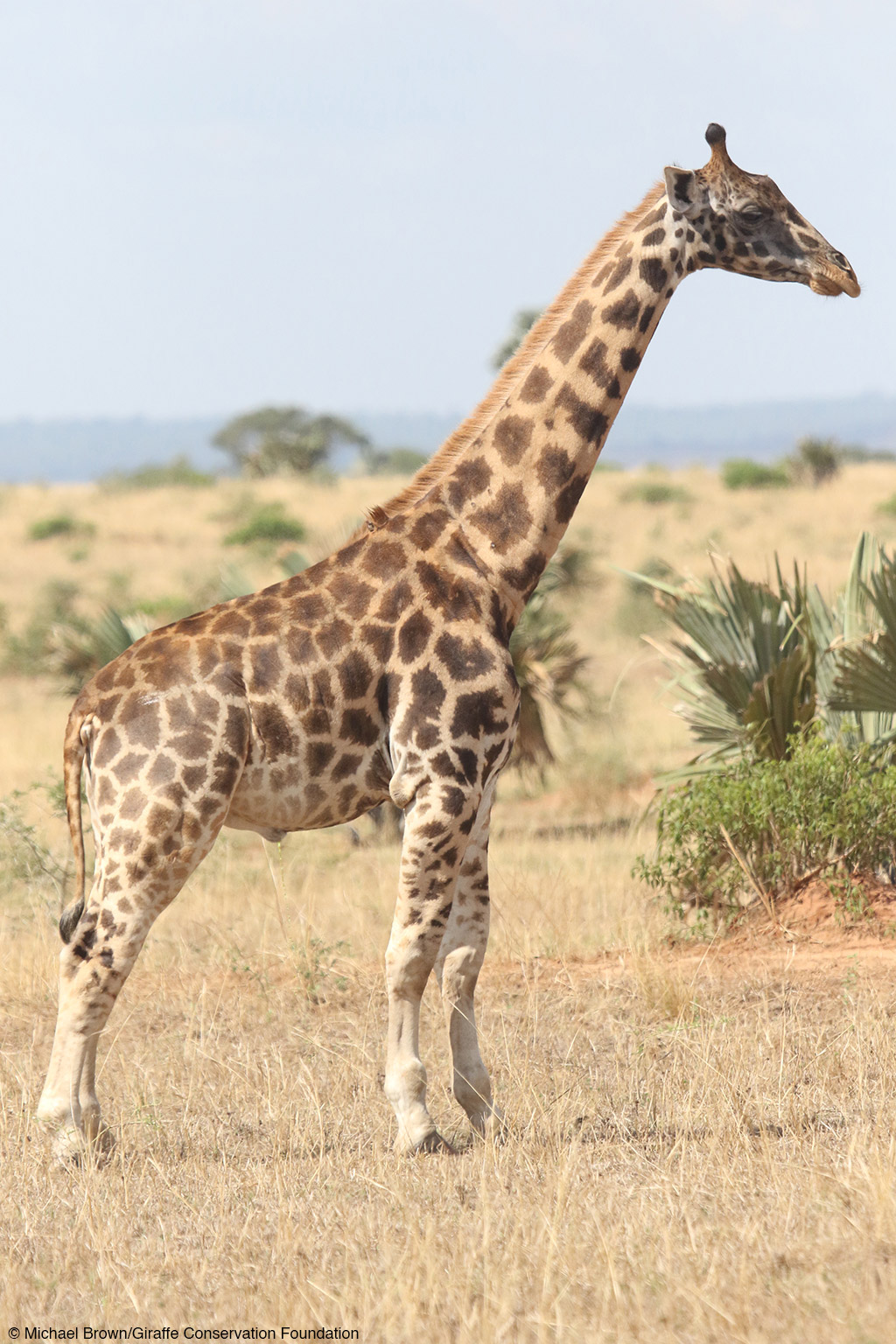
Gimli the dwarf giraffe in Uganda photographed in 2017
The study notes that Uganda’s giraffe population experienced a significant bottleneck in the late 1980s due to civil unrest and associated bushmeat poaching. However, it is unlikely (and unclear) if this particular giraffe – named ‘Gimli’ by the researchers in honour of Tolkien’s Lord of the Rings character – is related to a decrease in genetic diversity. It is unknown what effect, if any, these conditions might have on giraffe survival or reproduction, but fortunately the population is rebounding. In Namibia, ‘Nigel’ the dwarf giraffe, was born in 2014 and his unique body shape was first observed when he was about four years old; an age when male giraffe are close to maturity and fully gown. The GCF researchers will continue to monitor these two male giraffe to see if any observable variances in their behaviour and social status occur.
“While the Namibian farmer had spotted Nigel regularly over the years, it was only after our observations that he realised that Nigel was not a juvenile but a fully grown male giraffe”, said Emma Wells. “It is mainly in comparison to other giraffe that his difference in stature becomes obvious.”
Across Africa, giraffe have experienced significant population declines over the past 30 years, leading to a silent extinction crisis. Population monitoring efforts like those conducted by GCF and its partners in Namibia, Uganda and elsewhere are providing critical information to inform conservation efforts and ensure a future for wild giraffe throughout Africa. GCF estimates that only about 111,000 giraffe are remaining in the wild in all of Africa today.
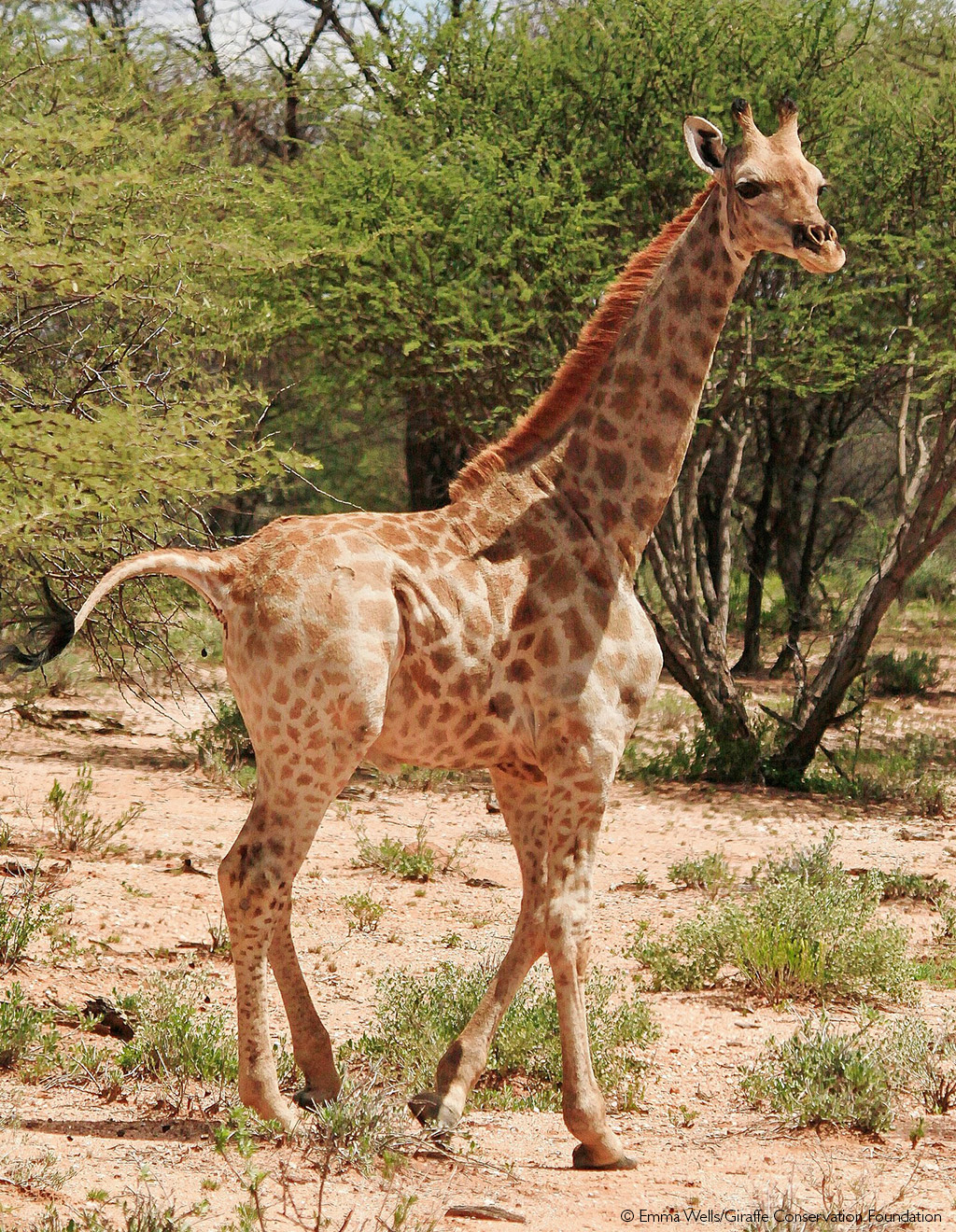
Dwarf giraffe photographed in Namibia in 2018
“Giraffe are undergoing a silent extinction in Africa. The fact that this is the first description of dwarf giraffe is just another example of how little we know about these charismatic animals”, said Dr Julian Fennessy, Director and Co-Founder of GCF. “It is only recently that our research has shown that there are four distinct species of giraffe. There is just so much more to learn about giraffe in Africa, and we need to stand tall now to save them before it is too late.”
About the Giraffe Conservation Foundation
The Giraffe Conservation Foundation (GCF) is the only organisation in the world that concentrates solely on the conservation and management of giraffe in the wild throughout Africa. GCF currently implements and supports giraffe conservation efforts in 16 African countries. As an international science-based conservation organisation, GCF that provides innovative approaches to saving giraffe. GCF is dedicated to a sustainable future for all giraffe populations in the wild. For more information, visit our website: https://giraffeconservation.org/
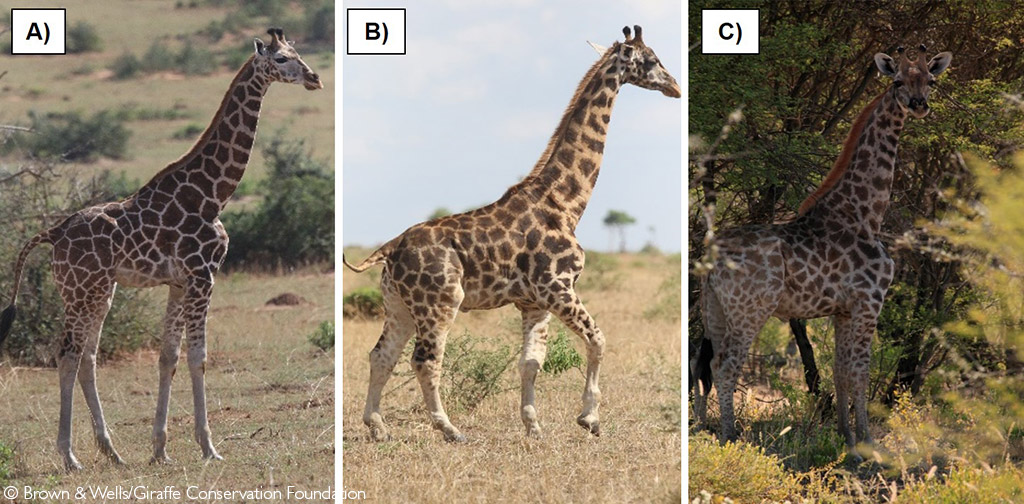
Lateral photographs of giraffe. A) A typical subadult male giraffe in Murchison Falls National Park, Uganda B) A subadult male exhibiting skeletal dysplasia-like syndrome in Murchison Falls National Park, Uganda. C) A subadult male exhibiting skeletal dysplasia like syndrome on a private farm in Namibia. (Figure from Brown & Wells, 2020.)
Posted on January 4, 2021 by Giraffe Conservation Foundation

By Giraffe Conservation Foundation
Researchers from the Giraffe Conservation Foundation (GCF) have recently published a paper in BMC Research Notes describing two dwarf giraffe in separate populations in Namibia and Uganda. This study represents the first known accounts of dwarf giraffe in the scientific literature. These giraffe were documented in Murchison Falls National Park, Uganda, and on a private farm in central Namibia during photographic surveys routinely conducted by GCF to determine numbers, population dynamics, and giraffe distribution throughout Africa. Using digital photogrammetry techniques, the researchers measured limb dimensions of the two dwarf giraffe and compared them to other giraffe in the populations, finding that these dwarf giraffe had shorter legs; more specifically, they had shorter radius and metacarpal bones compared to other giraffe of similar age. Click here to see a video of the dwarf giraffe in Murchison Falls, filmed by Dr Michael Brown.
“Instances of wild animals with these types of skeletal dysplasias are extraordinarily rare”, said lead author Dr Michael Brown. “It’s another interesting wrinkle in the unique story of giraffe in these diverse ecosystems.”

Gimli the dwarf giraffe in Uganda photographed in 2017
The study notes that Uganda’s giraffe population experienced a significant bottleneck in the late 1980s due to civil unrest and associated bushmeat poaching. However, it is unlikely (and unclear) if this particular giraffe – named ‘Gimli’ by the researchers in honour of Tolkien’s Lord of the Rings character – is related to a decrease in genetic diversity. It is unknown what effect, if any, these conditions might have on giraffe survival or reproduction, but fortunately the population is rebounding. In Namibia, ‘Nigel’ the dwarf giraffe, was born in 2014 and his unique body shape was first observed when he was about four years old; an age when male giraffe are close to maturity and fully gown. The GCF researchers will continue to monitor these two male giraffe to see if any observable variances in their behaviour and social status occur.
“While the Namibian farmer had spotted Nigel regularly over the years, it was only after our observations that he realised that Nigel was not a juvenile but a fully grown male giraffe”, said Emma Wells. “It is mainly in comparison to other giraffe that his difference in stature becomes obvious.”
Across Africa, giraffe have experienced significant population declines over the past 30 years, leading to a silent extinction crisis. Population monitoring efforts like those conducted by GCF and its partners in Namibia, Uganda and elsewhere are providing critical information to inform conservation efforts and ensure a future for wild giraffe throughout Africa. GCF estimates that only about 111,000 giraffe are remaining in the wild in all of Africa today.

Dwarf giraffe photographed in Namibia in 2018
“Giraffe are undergoing a silent extinction in Africa. The fact that this is the first description of dwarf giraffe is just another example of how little we know about these charismatic animals”, said Dr Julian Fennessy, Director and Co-Founder of GCF. “It is only recently that our research has shown that there are four distinct species of giraffe. There is just so much more to learn about giraffe in Africa, and we need to stand tall now to save them before it is too late.”
About the Giraffe Conservation Foundation
The Giraffe Conservation Foundation (GCF) is the only organisation in the world that concentrates solely on the conservation and management of giraffe in the wild throughout Africa. GCF currently implements and supports giraffe conservation efforts in 16 African countries. As an international science-based conservation organisation, GCF that provides innovative approaches to saving giraffe. GCF is dedicated to a sustainable future for all giraffe populations in the wild. For more information, visit our website: https://giraffeconservation.org/

Lateral photographs of giraffe. A) A typical subadult male giraffe in Murchison Falls National Park, Uganda B) A subadult male exhibiting skeletal dysplasia-like syndrome in Murchison Falls National Park, Uganda. C) A subadult male exhibiting skeletal dysplasia like syndrome on a private farm in Namibia. (Figure from Brown & Wells, 2020.)
"Education is the most powerful weapon which you can use to change the world." Nelson Mandela
The desire for equality must never exceed the demands of knowledge
The desire for equality must never exceed the demands of knowledge
- Richprins
- Committee Member
- Posts: 76101
- Joined: Sat May 19, 2012 3:52 pm
- Location: NELSPRUIT
- Contact:
Re: Giraffe
Please check Needs Attention pre-booking: https://africawild-forum.com/viewtopic.php?f=322&t=596
- Richprins
- Committee Member
- Posts: 76101
- Joined: Sat May 19, 2012 3:52 pm
- Location: NELSPRUIT
- Contact:
Re: Giraffe
Please check Needs Attention pre-booking: https://africawild-forum.com/viewtopic.php?f=322&t=596
- Lisbeth
- Site Admin
- Posts: 67578
- Joined: Sat May 19, 2012 12:31 pm
- Country: Switzerland
- Location: Lugano
- Contact:
Re: Giraffe
He just had trouble getting the foot out of the branches.
"Education is the most powerful weapon which you can use to change the world." Nelson Mandela
The desire for equality must never exceed the demands of knowledge
The desire for equality must never exceed the demands of knowledge
- Lisbeth
- Site Admin
- Posts: 67578
- Joined: Sat May 19, 2012 12:31 pm
- Country: Switzerland
- Location: Lugano
- Contact:
Re: Giraffe
Four giraffe species, seven subspecies: new research
Posted on May 28, 2021 by Team Africa Geographic in the DECODING SCIENCE post series
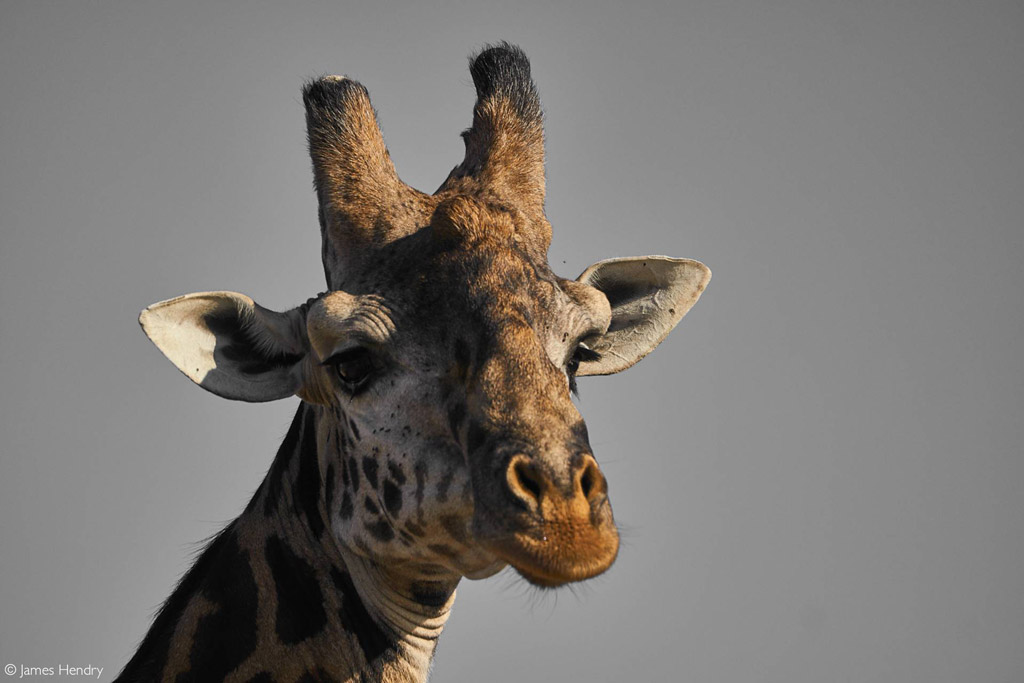
The classification of giraffe species and subspecies has proved unexpectedly contentious. Various scientists have suggested that giraffe be divided into anything from two to nine different species. New research facilitated by the Giraffe Conservation Foundation (GCF) confirms that a division into four giraffe species division is the correct approach. This, in turn, could have an important impact on giraffe conservation throughout Africa.
The four species identified by the study are:
1.
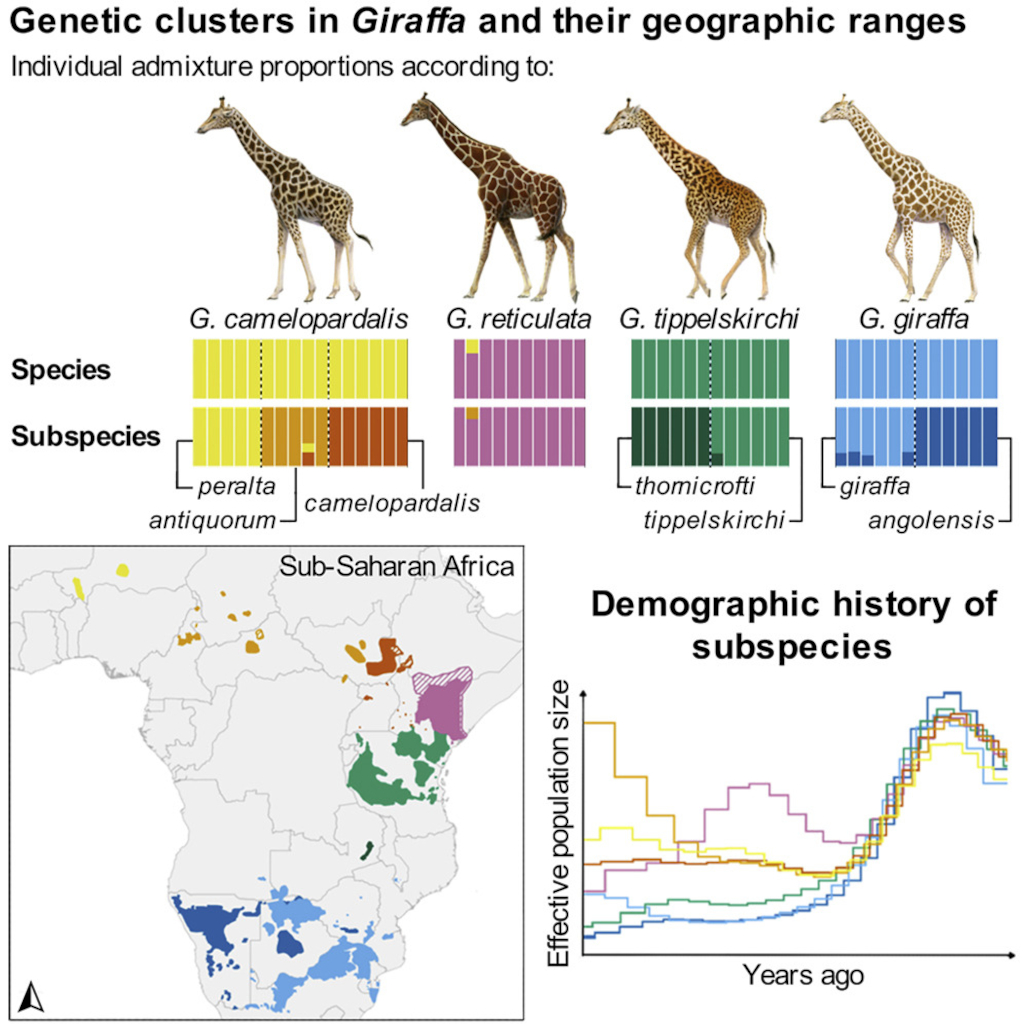
The northern giraffe is divided into three subspecies: the west African giraffe (G. c. peralta ~600 remaining), the Nubian giraffe (G. c. camelopardalis ~3,022 remaining) and the Kordofan giraffe (G. c. antiquorum ~2,297 remaining). The southern giraffe has two subspecies: the South African giraffe (G. g. giraffa ~20,675 remaining) and the Angolan giraffe (G. g. angolensis ~20,192 remaining). The study also suggests that the Luangwa giraffe (G. t. thornicrofti) should be recognised as a distinct subspecies of the Masai giraffe. The distinctions are important because some species/subspecies are of more conservation concern than others. The southern giraffe is the most common, while two subspecies of the northern giraffe are critically endangered.
At present, the IUCN only recognises one giraffe species classified on the Red List as ‘Vulnerable’. However, the IUCN also recognises nine different subspecies, each with a separate conservation status (although the South African giraffe has yet to be assessed). As in the case of the forest elephant, acknowledging new species takes time, especially when science does not provide an unequivocal answer and there is disagreement over what criteria to use when distinguishing species. For giraffe, some contention arose due to a degree of hybridisation in captivity.
The four-species division was initially suggested in 2016, based on collaborative research conducted by the GCF, Senckenberg Biodiversity and Climate Research Centre and partners. “We were extremely surprised to find such large genetic differences in giraffe in our initial study as their morphological and coat pattern differences appear limited,” says Dr Axel Janke, a geneticist at the Senckenberg Biodiversity and Climate Research Centre and Goethe University in Germany. “However, to put our results into perspective, the genetic differences between the distinct giraffe species are similar to those between polar and brown bears.”
Nevertheless, the 2016 study was met with some controversy, and debate ensued about the correct classification. However, the new research published this month was analysed with additional experts from the Smithsonian Conservation Biology Institute, Chinese Academy of Sciences and ITMO University to produce the most inclusive genomic level analysis of giraffe relationships. The researchers conclude that the four distinct giraffe lineages diverged between 230,000 and 370,000 years ago.
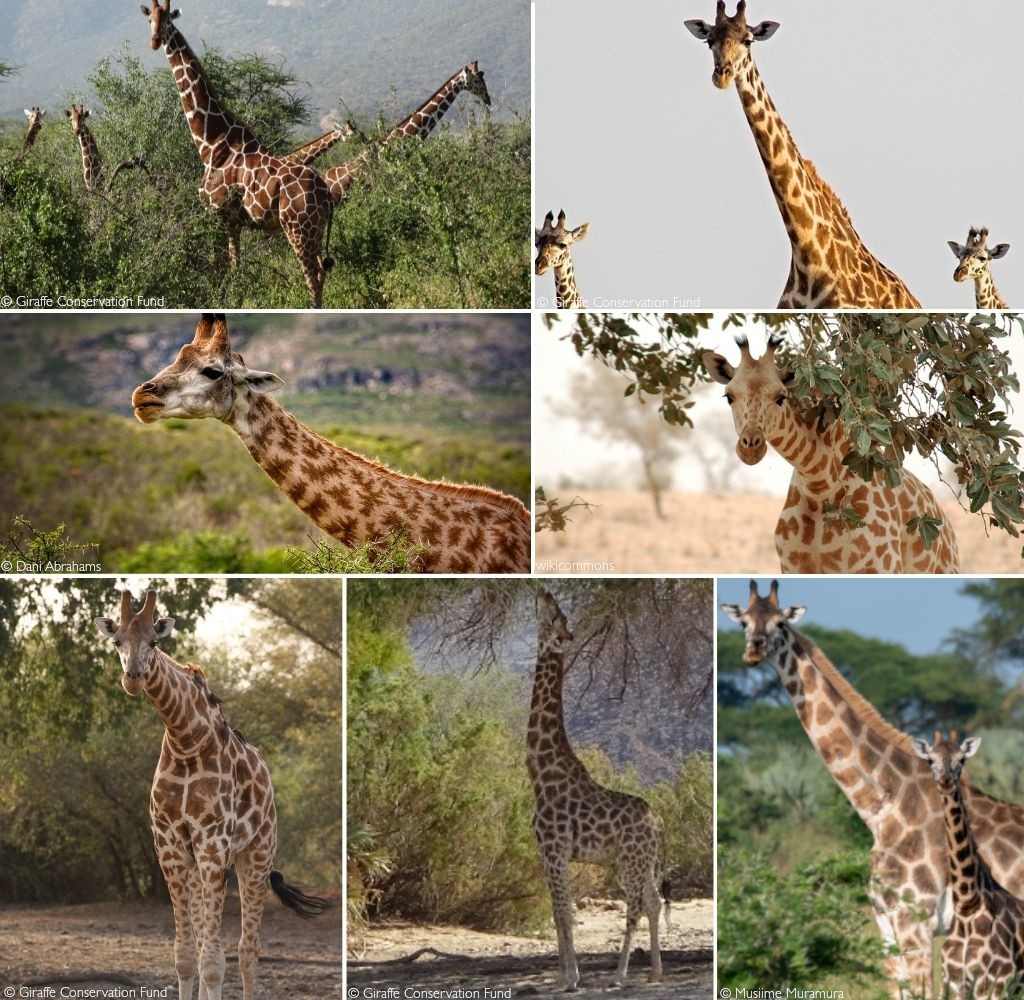
Clockwise from top left: Reticulated giraffe, Masai giraffe, west African giraffe, Nubian giraffe (courtesy www.afripixo.com), Angolan giraffe, Kordofan giraffe, South African giraffe
Why is this important? “We estimate that there are fewer than 6,000 northern giraffe remaining in the wild. Their numbers have declined by more than 90% in the last 35 years. As a species, they are one of the most threatened large mammals in the world, and we need to urgently increase our protection efforts of this species before it is too late. The conservation implications of this genetic research are immense, and it would be ignorant to ignore these new findings. It’s time to act now!” says Dr Julian Fennessy of GCF.
Genomics is vitally important to our understanding of species and subspecies divisions, and, most importantly, it is enhancing our perception of biodiversity. Not only does it highlight how vital it is to act on this research to conserve what remains, but it also serves as a sobering warning about how much we may have lost already without knowing. In the case of the giraffe, there is still time to appreciate the significant differences between the various species and protect those that remain.
For further reading, see: Giraffes – the Silent Extinction
The complete study can be accessed here: “Whole-genome analysis of giraffe supports four distinct species”, Coimbra, R. T. F., et al., (2021) Current Biology
Posted on May 28, 2021 by Team Africa Geographic in the DECODING SCIENCE post series

The classification of giraffe species and subspecies has proved unexpectedly contentious. Various scientists have suggested that giraffe be divided into anything from two to nine different species. New research facilitated by the Giraffe Conservation Foundation (GCF) confirms that a division into four giraffe species division is the correct approach. This, in turn, could have an important impact on giraffe conservation throughout Africa.
The four species identified by the study are:
1.
- Northern giraffe (Giraffa camelopardalis – ~5,919 remaining)
- Southern giraffe (Giraffa giraffa ~49,867 remaining)
- Masai giraffe (Giraffa tippelskirchi ~45,402 remaining)
- Reticulated giraffe (Giraffa reticulata ~15,985 remaining)

The northern giraffe is divided into three subspecies: the west African giraffe (G. c. peralta ~600 remaining), the Nubian giraffe (G. c. camelopardalis ~3,022 remaining) and the Kordofan giraffe (G. c. antiquorum ~2,297 remaining). The southern giraffe has two subspecies: the South African giraffe (G. g. giraffa ~20,675 remaining) and the Angolan giraffe (G. g. angolensis ~20,192 remaining). The study also suggests that the Luangwa giraffe (G. t. thornicrofti) should be recognised as a distinct subspecies of the Masai giraffe. The distinctions are important because some species/subspecies are of more conservation concern than others. The southern giraffe is the most common, while two subspecies of the northern giraffe are critically endangered.
At present, the IUCN only recognises one giraffe species classified on the Red List as ‘Vulnerable’. However, the IUCN also recognises nine different subspecies, each with a separate conservation status (although the South African giraffe has yet to be assessed). As in the case of the forest elephant, acknowledging new species takes time, especially when science does not provide an unequivocal answer and there is disagreement over what criteria to use when distinguishing species. For giraffe, some contention arose due to a degree of hybridisation in captivity.
The four-species division was initially suggested in 2016, based on collaborative research conducted by the GCF, Senckenberg Biodiversity and Climate Research Centre and partners. “We were extremely surprised to find such large genetic differences in giraffe in our initial study as their morphological and coat pattern differences appear limited,” says Dr Axel Janke, a geneticist at the Senckenberg Biodiversity and Climate Research Centre and Goethe University in Germany. “However, to put our results into perspective, the genetic differences between the distinct giraffe species are similar to those between polar and brown bears.”
Nevertheless, the 2016 study was met with some controversy, and debate ensued about the correct classification. However, the new research published this month was analysed with additional experts from the Smithsonian Conservation Biology Institute, Chinese Academy of Sciences and ITMO University to produce the most inclusive genomic level analysis of giraffe relationships. The researchers conclude that the four distinct giraffe lineages diverged between 230,000 and 370,000 years ago.

Clockwise from top left: Reticulated giraffe, Masai giraffe, west African giraffe, Nubian giraffe (courtesy www.afripixo.com), Angolan giraffe, Kordofan giraffe, South African giraffe
Why is this important? “We estimate that there are fewer than 6,000 northern giraffe remaining in the wild. Their numbers have declined by more than 90% in the last 35 years. As a species, they are one of the most threatened large mammals in the world, and we need to urgently increase our protection efforts of this species before it is too late. The conservation implications of this genetic research are immense, and it would be ignorant to ignore these new findings. It’s time to act now!” says Dr Julian Fennessy of GCF.
Genomics is vitally important to our understanding of species and subspecies divisions, and, most importantly, it is enhancing our perception of biodiversity. Not only does it highlight how vital it is to act on this research to conserve what remains, but it also serves as a sobering warning about how much we may have lost already without knowing. In the case of the giraffe, there is still time to appreciate the significant differences between the various species and protect those that remain.
For further reading, see: Giraffes – the Silent Extinction
The complete study can be accessed here: “Whole-genome analysis of giraffe supports four distinct species”, Coimbra, R. T. F., et al., (2021) Current Biology
"Education is the most powerful weapon which you can use to change the world." Nelson Mandela
The desire for equality must never exceed the demands of knowledge
The desire for equality must never exceed the demands of knowledge
- Richprins
- Committee Member
- Posts: 76101
- Joined: Sat May 19, 2012 3:52 pm
- Location: NELSPRUIT
- Contact:
Re: Giraffe
They have hopefully now decided which species are which! 
Please check Needs Attention pre-booking: https://africawild-forum.com/viewtopic.php?f=322&t=596
- Lisbeth
- Site Admin
- Posts: 67578
- Joined: Sat May 19, 2012 12:31 pm
- Country: Switzerland
- Location: Lugano
- Contact:
Re: Giraffe
It's years that they go on changing their mind 
"Education is the most powerful weapon which you can use to change the world." Nelson Mandela
The desire for equality must never exceed the demands of knowledge
The desire for equality must never exceed the demands of knowledge


